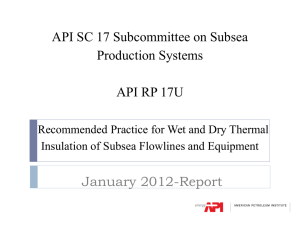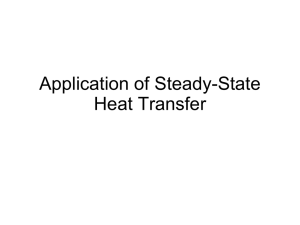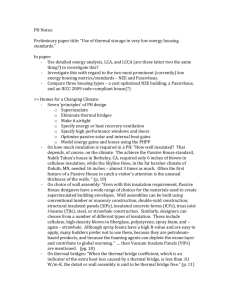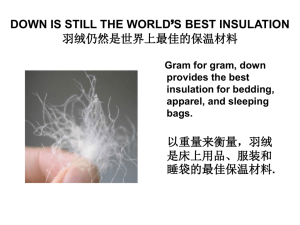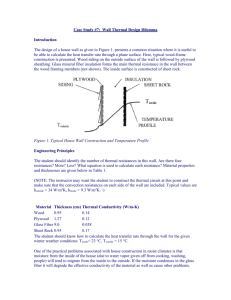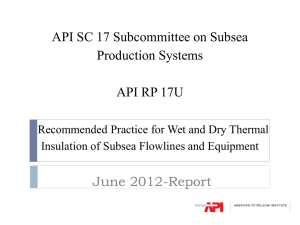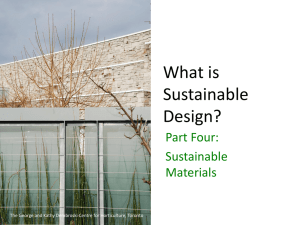Conduction - ThermalNet
advertisement
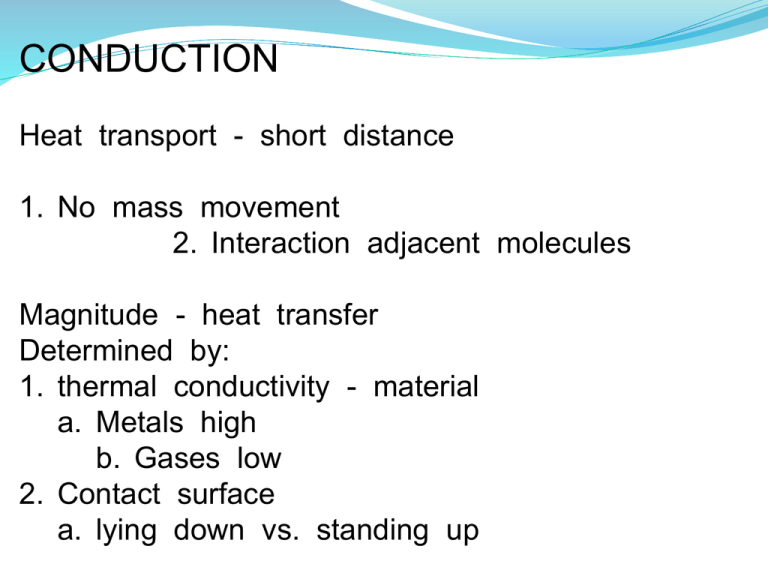
CONDUCTION Heat transport - short distance 1. No mass movement 2. Interaction adjacent molecules Magnitude - heat transfer Determined by: 1. thermal conductivity - material a. Metals high b. Gases low 2. Contact surface a. lying down vs. standing up Resting human or standing animal Heat exchange via conduction - usually small Often neglected - heat balance studies Air layer against skin = pathway for conduction BUT - air has low thermal conductivity Therefore - small role - total transfer Heat transfer feet >> ground = small contact area Hoofed animal - distance between blood vessels & surface much greater than in feet Conductive heat transfer increases with animal lying on cool/wet surfaces Greater import. under these conditions 1. substrate thermal conductance 2. temperature gradient 3. area of contact relative to total surface area Sheep - lying on cold, poorly insulated ground dissipates up to 30% minimum heat production by conduction. If temperature of substrate is greater than body temperature •gradient is reversed - heat inflow via conduction and increases heat load. Floor material - important for animals such as pigs (~20% - pig’s surface - may be in contact with floor) Thermal capacity - floor material - very important Density of material x specific heat = thermal capacity Different materials affect instantaneous fall in temperature Feeling of warmth - related to instantaneous temperature drop Assumed that floor would not feel very cold if: Instantaneous drop did not exceed 1.6F at Ta = 64.5 F (wood floor) 40 kg animal - LCT = 11.5 - 13.0 C straw (thermal insulation + decreases heat flow > floor) = 14.0 - 15.0 C asphalt = 19.0 - 20.0 C concrete Newborn pig at Ta = 10 C - Moving animal from bare concrete >> straw has same thermal effect on metabolism as increasing Ta > 18 C. Heat Transfer - warming food or drink usually insignificant. If a 20 kg pig drinks 2.5 L/day and water temp. = 20 C Pig puts 200 kJ into water to raise it to deep body Temperature MR = 6700 kJ / day Therefore - a 3% shift (same found for sheep). _________________________________________ What is tissue insulation? Resistance offered to heat flow between heat-producing tissues and skin surface. Dependent on: 1. Thickness - subcutaneous fat 2. Vasomotor changes - blood flow Internal thermal conductance = combination - 2 heat transfer channels 1. 2. Conduction - heat through muscle and fat layers Convection - heat transfer via blood Tissue Insulation (°C x m2 x W-1) ________________________________________________ Calf 0.09 0.04 (vasoconstriction) (vasodilation) Adult Steer 0.14 0.04 ________________________________________________ • Cold Ta conductance - not greatly affected by Ta In theory - fully vasoconstricted at LCT Minimal peripheral blood flow Likewise - after vasodilation - little additional increase in peripheral blood flow External Insulation (Animal Coat or Clothing Insuln.) + (Air - Ambient Insuln.) (Air - Ambient Insuln.) = region between surface of coat or bare skin and environment Hair Coat Insulation (°C x m2 x W-1) ________________________________________________ Calf 0.11 0.16 (unerected) (erected) ________________________________________________ 1. Hair coat insulation increases with coat dept 2. Air trapped between fibers 3. Wind velocity decreases amount of trapped air (mW x m-1 x °C-1) ______________________________________________ Thermal conductivity still air (20°C) 25 Coats - artic mammals 55 ________________________________________________ COAT TYPE - IMPORTANT Decrease in thermal insulation with less still air Insulation of dead fat - greater than for live fat – WHY INSULATION DENSITY Barnett - used isolated mouse skin Insulation = 0.069°C/m2/W-1 for a unit hair density (1 mg/cm-2) Insulation of mouse coat - using these units = 4 times that of pig hair of same density and 10 times that of calf WHY GREATER INSULATION VALUE OF MOUSE FUR? Possibly - greater # - fine hairs (wt for wt) & more effective layer - trapped air Measurement of density as number hairs / unit area may be more useful comparison - than meas. - density as weight of hair / unit area Coat Density - very important Thick coat - husky dog - so dense - it can sleep comfortably on snow - with no melting on tips of hairs • Wind - less effect on dense coats than sparse coats Dividing line - sparse and dense = 1,000 hairs/cm2 Coat also important - preventing heat gain - hot environments External Insulation - Birds Plumage = effective barrier - heat loss 1. Down feathers - traps air >> little convection 2. Contour feathers - distal parts >> windproof cover • Chicks without contours - have a problem Water Problem 1. thin layer oil - preen gland 2. + spaces between finest divisions feather structure - extremely small • Both factors >> plumage with high resistance wetting Thermal insulation - greater in larger birds 1. Able to carry heavier load feathers than small birds 2. Because of radial distribution of feathers - smaller objects (torso, extremities) have less compact insulation Definite benefit during cold exposure Some birds elevate feathers during expsoure solar radiation Permits better circulation - air through plumage & incr. heat loss Acclimation - warm Ta > decr. plumage - domestic fowl Some birds - winter plumage may be 30% greater than summer
